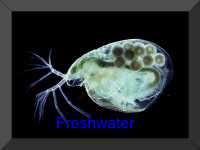BACK TO <<<
>>>

BACK TO <<<
>>>

Aka : Millers Thumb Tommy Logge



The bullhead Cottus gobio L. is the only freshwater cottid found in the UK. The Cottidae (sculpins) are mostly marine fish, with around 300 species worldwide. A small species, the bullhead exceptionally reaches 15 cm in length and a weight of 28g. It is easily identified by its large head (which can account for 25% of body length) with eyes on the top and a dorso-ventrally flattened tapering body adapted to life on the bottom of flowing waters.
In the British Isles it is common in England and Wales, excluding northwest Wales. The bullhead is also absent from Ireland and present in only three catchments in Scotland: the Clyde, Forth and Don.
Diet
Benthic invertebrates comprise the bulk of the diet.The bullhead’s large eyes and special corneal arrangement may help it to forage effectively in low light.
Breeding
Bullheads spawn from February to June: typically once for females in upland streams, and up to four
times in warmer, more productive lowland streamsLife Span
They do not generally live for more than three or four years, although fish of over 10 years old have
been recorded.Predators
Being small, bullheads are vulnerable to a range of predators. Brown trout are the principal threat,
including Pike (Esox lucius). Eel (Anguilla anguilla), Chub ( Leuciscus cephalus), and Perch (Perca fluviatilis),are also likely to take bullheads. Bullheads fall prey to piscivorousbirds, particularly the Grey Heron (Ardea cinerea), Kingfisher ( Alcedo atthis ), as well as the Dipper ( Cinclus cinclus ). .The introduced North American Signal crayfish ( Pacifastacus eniusculus), has been proven to havea detrimental effect on bullhead populations, unlike the native White Clawed Crayfish (Austropotamo biuspallipes). It has been shown that there is an inversecorrelation between the number o fsignal crayfish and benthic fishspecies, including bullhead. Signal Crayfish affect bullhead densitythrough competition for shelter and food, in addition to predation of bullhead eggs and direct predation of
adults by larger individuals.Invertebrate predators may take a toll of bullhead eggs. the caddis larvae Halesus digitatus and Potamophylaxcingulatus are the most prolific.